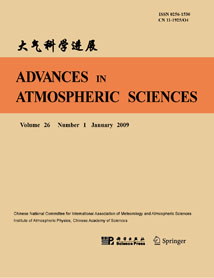| [1] |
Qian Yongfu,
1987: RECURRENCE METHOD FOR CALCULATION OF ATMOS-PHERIC COOLING RATE DUE TO INFRARED RADIATION, ADVANCES IN ATMOSPHERIC SCIENCES, 4, 403-413.
doi: 10.1007/BF02656741
|
| [2] |
Shi Guangyu, Qu Yanni,
1986: EFFECTS OF RADIATION MODELS ON THE CALCULATION OF ATMOSPHERIC INFRARED COOLING RATES, ADVANCES IN ATMOSPHERIC SCIENCES, 3, 227-237.
doi: 10.1007/BF02682556
|
| [3] |
Xun Zhu,
1989: A Parameterization of Cooling Rate Calculation under the Non-LTE Condition: Multi-Level Model, ADVANCES IN ATMOSPHERIC SCIENCES, 6, 403-413.
doi: 10.1007/BF02659075
|
| [4] |
LIU Weiyi, QIU Jinhuan,
2012: A Parameterized yet Accurate Model of Ozone and Water Vapor Transmittance in the Solar-to-near-infrared Spectrum, ADVANCES IN ATMOSPHERIC SCIENCES, 29, 599-610.
doi: 10.1007/s00376-011-1076-6
|
| [5] |
Zhao Gaoxiang,
1998: Analysis of the Ability of Infrared Water Vapor Channel for Moisture Remote Sensing in the Lower Atmosphere, ADVANCES IN ATMOSPHERIC SCIENCES, 15, 107-112.
doi: 10.1007/s00376-998-0022-8
|
| [6] |
Ling WANG, Xiuqing HU, Na XU, Lin CHEN,
2021: Water Vapor Retrievals from Near-infrared Channels of the Advanced Medium Resolution Spectral Imager Instrument onboard the Fengyun-3D Satellite, ADVANCES IN ATMOSPHERIC SCIENCES, 38, 1351-1366.
doi: 10.1007/s00376-020-0174-8
|
| [7] |
YANG Lu, WANG Zhenhui, CHU Yanli, ZHAO Hang, TANG Min,
2014: Water Vapor Motion Signal Extraction from FY-2E Longwave Infrared Window Images for Cloud-free Regions: The Temporal Difference Technique, ADVANCES IN ATMOSPHERIC SCIENCES, 31, 1386-1394.
doi: 10.1007/s00376-014-3165-9
|
| [8] |
B. J. SOHN,
2024: Water Vapor Information from Satellite and Its Applications, ADVANCES IN ATMOSPHERIC SCIENCES, 41, 188-189.
doi: 10.1007/s00376-023-3008-7
|
| [9] |
Huipeng Wang, Jiagen Li, Junqiang Song, Liang Sun, Fu Liu, Han Zhang, Kaijun Ren, Huizan Wang, Chunming Wang, Jinrong Zhang, Hongze Leng,
2024: Limited sea surface temperature cooling due to the barrier layer promoting Super Typhoon Mangkhut (2018), ADVANCES IN ATMOSPHERIC SCIENCES.
doi: 10.1007/s00376-024-3268-x
|
| [10] |
LI Guoqing, ZONG Haifeng, ZHANG Qingyun,
2011: 27.3-day and Average 13.6-day Periodic Oscillations in the Earth's Rotation Rate and Atmospheric Pressure Fields Due to Celestial Gravitation Forcing, ADVANCES IN ATMOSPHERIC SCIENCES, 28, 45-58.
doi: 10.1007/s00376-010-0011-6
|
| [11] |
XU Xiangde, MIAO Qiuju, WANG Jizhi, ZHANG Xuejin,
2003: The Water Vapor Transport Model at the Regional Boundary during the Meiyu Period, ADVANCES IN ATMOSPHERIC SCIENCES, 20, 333-342.
doi: 10.1007/BF02690791
|
| [12] |
TIAN Wenshou, Martyn P. CHIPPERFIELD, LU Daren,
2009: Impact of Increasing Stratospheric Water Vapor on Ozone Depletion and Temperature Change, ADVANCES IN ATMOSPHERIC SCIENCES, 26, 423-437.
doi: 10.1007/s00376-009-0423-3
|
| [13] |
BI Yun, CHEN Yuejuan, ZHOU Renjun, YI Mingjian, DENG Shumei,
2011: Simulation of the Effect of Water-vapor Increase on Temperature in the Stratosphere, ADVANCES IN ATMOSPHERIC SCIENCES, 28, 832-842.
doi: 10.1007/s00376-010-0047-7
|
| [14] |
Yi Lan,
1995: Characteristics of the Mean Water Vapor Transport over Monsoon Asia, ADVANCES IN ATMOSPHERIC SCIENCES, 12, 195-206.
doi: 10.1007/BF02656832
|
| [15] |
SUN Li, SHEN Baizhu, SUI Bo,
2010: A Study on Water Vapor Transport and Budget of Heavy Rain in Northeast China, ADVANCES IN ATMOSPHERIC SCIENCES, 27, 1399-1414.
doi: 10.1007/s00376-010-9087-2
|
| [16] |
SUN Bo, ZHU Yali, WANG Huijun,
2011: The Recent Interdecadal and Interannual Variation of Water Vapor Transport over Eastern China, ADVANCES IN ATMOSPHERIC SCIENCES, 28, 1039-1048.
doi: 10.1007/s00376-010-0093-1
|
| [17] |
Licheng FENG, Rong-Hua ZHANG, Bo YU, Xue HAN,
2020: Roles of Wind Stress and Subsurface Cold Water in the Second-Year Cooling of the 2017/18 La Niña Event, ADVANCES IN ATMOSPHERIC SCIENCES, 37, 847-860.
doi: 10.1007/s00376-020-0028-4
|
| [18] |
Eun-Han KWON, Jinlong LI, B. J. SOHN, Elisabeth WEISZ,
2012: Use of Total Precipitable Water Classification of A Priori Error and Quality Control in Atmospheric Temperature and Water Vapor Sounding Retrieval, ADVANCES IN ATMOSPHERIC SCIENCES, 29, 263-273.
doi: 10.1007/s00376-011-1119-z
|
| [19] |
Junhong Wang, Harold L. Cole, David J. Carlson,
2001: Water Vapor Variability in the Tropical Western Pacific from 20-year Radiosonde Data, ADVANCES IN ATMOSPHERIC SCIENCES, 18, 752-766.
|
| [20] |
Zhang Renhe,
2001: Relations of Water Vapor Transport from Indian Monsoon with That over East Asia and the Summer Rainfall in China, ADVANCES IN ATMOSPHERIC SCIENCES, 18, 1005-1017.
|















 AAS Website
AAS Website 
 AAS WeChat
AAS WeChat 
 DownLoad:
DownLoad: